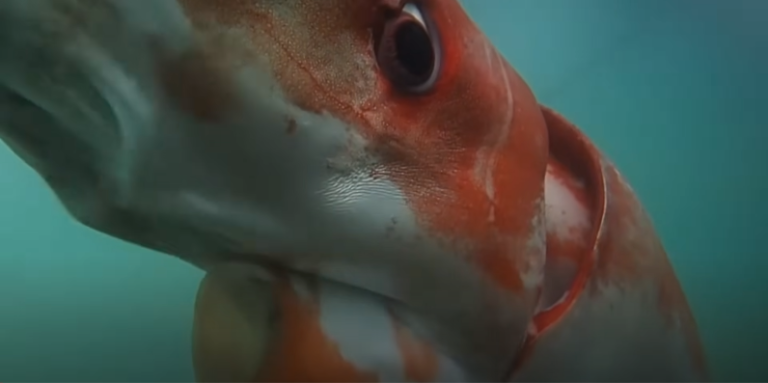
Introduction
Among the numerous amazing species that call the deep-water home are the giant squid and colossal squid, which are truly enigmas in their own right. These enormous cephalopods are similar to one another, but they also stand out from one another in certain ways. This article compares and examines the ten main distinctions between enormous and giant squid by delving into the ocean’s depths.
Size Difference of Giant Squid and Colossal Squids

One of the most obvious differences between the giant squid (Architeuthis dux) and the colossal squid (Mesonychoteuthis hamiltoni) is their size. While both are huge in their own right, the colossal squid is typically considered the largest of the two. Giant squids can reach lengths of up to 43 feet, but colossal squids can grow to be 46 feet long, according to reports. The sheer enormity of these creatures adds mystery to their existence.
Tentacle Length and Club Size
Beyond overall size, the tentacles of these deep-sea giant squid and colossal squid showcase notable differences. Giant squid possess longer tentacles with distinctive serrated suckers along their length. In contrast, colossal squid have shorter tentacles but boast larger clubs at the tips, armed with sharp hooks. This distinction in appendage morphology reflects their distinct hunting strategies and prey preferences.
Eyes of the Deep
These giant squid and colossal squid are categorized on the family of cephalopods, whose eyes are portals into their dark, enigmatic surroundings. Giant squid are said to have the largest eyes in the animal kingdom, measuring up to 10 inches in diameter. Colossal squid have slightly smaller eyes, but what distinguishes them is the presence of light-producing organs called photophores around their eyes. These adaptations aid in counter-illumination, allowing them to blend into the ambient light of the ocean depths while avoiding predators and prey.
Distribution and Habitat of Giant and Colossal Squids
The geographical distribution of these giant cephalopods (giant squid and colossal squid) varies, indicating their adaption to specific maritime habitats. Giant squid live in deep-sea areas around the planet, from the Atlantic to the Pacific. Colossal squid, on the other hand, are largely linked with the icy waters of the Southern Ocean, particularly the Antarctic region. This variation in distribution emphasises the species’ distinct ecological niches.
Beak Shape and Jaw Strength
The giant squid and colossal squid beaks vary in shape and power. Giant squids have a strong and powerful beak designed to smash their prey’s shells. Colossal squids have stronger jaws and larger beaks, allowing them to hunt more aggressively. Their beaks are powerful instruments capable of capturing and subduing a wide range of prey, including fish and other squid species.
Mantle and Fin Structure
While examining the mantle and fin structure of giant squid and colossal squid, scientists provide additional information on the differences between these cephalopods. The mantle of the enormous squid is more muscular and stronger than that of the giant squid. This modification helps the enormous squid move rapidly and efficiently in the deep sea, allowing it to effectively pursue prey or escape predators.

Reproductive Strategies
Giant squid and Colossal squids reproduce using distinct techniques. Giant squid are recognised for their unique reproduction method, in which males utilise a specialised arm called a hectocotylus to carry sperm packets to females. Colossal squid, on the other hand, have a more traditional reproductive system in which males use specialised adapted arms to deliver sperm. These various reproduction tactics demonstrate the evolutionary adaptations that these cephalopods have undergone over millions of years.
Feeding Behaviour of Giant and Colossal Squids
While both species of giant squid and colossal squid are fearsome predators, their feeding behaviours differ. Giant squid are supposed to hunt largely with their lengthy tentacles, capturing prey. In contrast, enormous squid use a more aggressive strategy, seizing and immobilising prey using their muscular arms and massive tentacular clubs loaded with hooks. The distinctions in feeding habits correspond to their respective morphological adaptations and ecological responsibilities in the deep-sea ecosystem.
DNA and Genetic Diversity of Giant and Colossal Squids
Advances in genetic studies have enabled scientists to investigate the DNA and genetic variety of these mysterious organisms. Studies have found small genetic variations between giant squid and colossal squid, providing insight into their evolutionary history and potential divergence. These genetic findings help us better grasp the complicated links within the cephalopod family.
Elusiveness and Scientific Study
Despite decades of research on enormous giant squid and colossal squid remain mysterious and difficult to study in their natural environments. The elusiveness of these deep-sea organisms has piqued scientific interest and encouraged novel study methods, such as the employment of specialised submersibles and remotely operated vehicles. The limited observations and specimens acquired add to the ongoing enigma surrounding these giant cephalopods, emphasising the importance of further exploration and scientific research.
Conclusion
The giant squid and colossal squid, which live in the deep ocean mainly in the pacific region, fascinate our imaginations with their enormous size, intriguing behaviours, and unusual adaptations. While these massive creatures share common characteristics as members of the cephalopod family, they differ significantly in size, shape, habitat, and activity. As technology progresses and research skills improve, the mysteries of the deep water are progressively revealed, providing glimpses into the lives of these incredible creatures who have captivated humans for ages.
